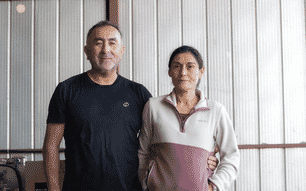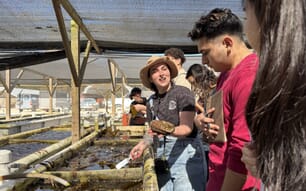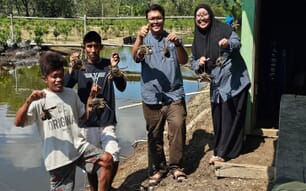Pedro Alvarez, IDI director of iMare Natural, reports on the project to date.

Can you provide a brief overview of the company?
iMare Natural is a spin-out from the University of Granada, which is focused on developing methods of raising sea anemones. The techniques are based upon the correct use and recirculation of discarded organic products that result from the integrated multi-trophic (IMTA) cultivation of sea anemones with echinoderms and chenopodiaceae (salty plants).
How widely practiced is sea anemone aquaculture?
Anemonia sulcata is a new specie in the aquaculture sector, but the results obtained from our research confirm that it is well suited to aquaculture because of its biology, its capacity to acclimatise to captivity and its low production costs.
Why has sea anemone aquaculture become necessary?
The best alternative to fishery overharvesting is aquaculture. This kind of farming allows for a consistent harvest of seafood under controlled conditions and invertebrates provide an important nutritional supplement to diets around the world.
As the human population grows, the production of aquatic invertebrates and plants will become more important. They are simple and cheap to produce, tend to have shorter growth times and are often of high nutritional value.
Our research aims to create new systems for the culture of marine species that are at risk because they are overharvested, and improve the system design and economic performance of both aquaculture and natural production, using sustainable multi-trophic systems, combining aquaculture and aquaponics.

iMare Natural is pioneering the culture of Anemonia sulcata
What are the main challenges to producing anemones in captivity?
Sea anemones adapt well to captive conditions, both in open and closed systems (RAS), provided that they are given the appropriate hydraulic, physical-chemical and environmental lighting conditions.
Once these appropriate conditions are in place, the results are truly amazing: adaptation to a new environment, ease of maintenance, growth and even induced healing after asexual and sexual reproduction. They can even withstand high concentrations of dissolved nitrogen compounds.
There are, however, still some bottlenecks which must be overcome in order to achieve fully sustainable anemone farming.
One of these is the year-round development of new anemones via sexual reproduction. Overcoming this would increase the numbers of anemones that we could produced, which would negate the need to capture wild broodstock. It would also reduce the time spent in the asexual reproduction by division induced. Induced asexual reproduction involves high level of stress for the animals, which can delay their growth.
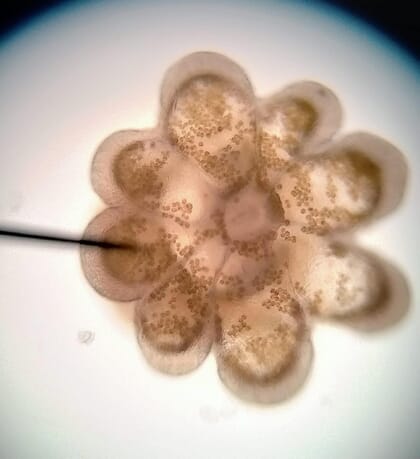
A second bottleneck relates to obtaining a sustainable feed supply. Anemones’ diets are based upon fish, mussels, crustaceans and other marine invertebrates. Unlike marine fish species, they do not require large amounts of food, so production costs are relatively low. But if the sector was to scale-up, if we use a diet in which all raw materials come from capture fisheries, it would not be sustainable. We therefore need to find other formulations, with raw materials that come from sustainably cultured marine organisms, vegetable proteins, etc. In fact, one of our current research lines is the search for a diet that provides the right nutritional value, while being both economically viable and environmentally sustainable.
There are some similarities between the cultivation of sea anemones and corals: both require a good flow of water, adequate intense lighting and good water quality.
Good water quality, has great relevance because all marine invertebrates are very sensitive to the dissolved nitrogenous compounds. Similarly, other physical-chemical parameters of water (Tª, salinity, pH, phosphate, calcium, and trace elements) must be perfectly balanced to ensure the viability of farming.
How long do you grow them in the facility before you release them into the ocean?
We estimate that it will take around two years before they reach the required size after sexual reproduction. For asexual reproduction it's much less - only around 45 days.
How have you funded your project so far?
The present study is being carried out within the ORTIMAR framework project "Strategies for reproduction in captivity of Anemonia sulcata, to optimize its reintroduction into the natural environment" (Fundación Biodiversidad, Programa Pleamar, España).
This study focuses on developing breeding strategies for the culture of sea anemones (Anemonia viridis and Anemonia sulcata) in captivity in order to repopulate the seabed off the coast of Granada, in southern of Spain. After a previous evaluation of the conservation status of this species on the coast of Granada, three areas were selected for sampling and collection of specimens to adapt them to culture conditions. Optimal culture conditions were calculated, according to feeding and nutritional requirements, hydrodynamics of water, light incidence, and tolerance to the main physicochemical parameters of water. Throughout the experimental period, biometric parameters of specimens of the different population lines were monitored and a strategy to multiply the stock through induced asexual reproduction was defined. A study of their reproductive cycle was made too and, finally, we established a design to fix the clones to structures to help with their reintroduction into the natural environment.
We would like to up-scale it and expand the restocking areas along the entire Andalusian coastline. We would also like to extend the project to consolidate optimal culture conditions and sexual reproduction techniques, to allow us to restock new specimens with genetic variability, to ensure the conservation of this overexploited species.
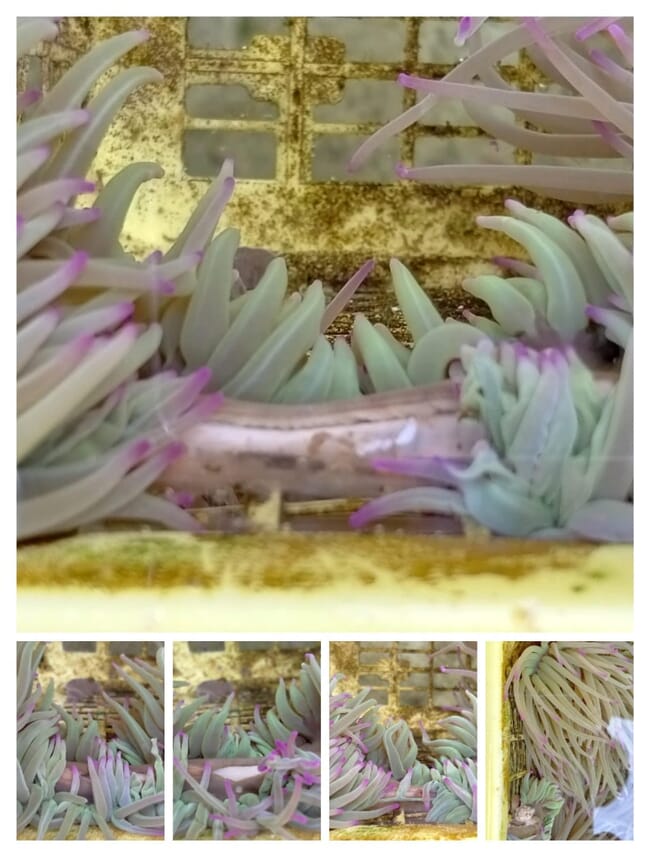
Do you plan to grow some to market size in the facility?
At the moment we are focused on restoring wild populations, rather than selling them direct to consumers. This is largely because re-stocking activities require as many sea anemones as possible to be successful.
How effective is growing the anemones in an IMTA system?
After 45 days in the IMTA system, the population of sea anemones experienced a 50 percent increase of total biomass. Furthermore the number of individuals increased due to asexual reproduction (bipartition).
Meanwhile, the population of anemones maintained in filtered water did not increase in number and suffered a 33 percent drop in weight. These results clearly demonstrate the protein value of the mashed suspended feed that we gave to the anemones, the flocculated microorganisms present in the RAS, and the great future that this species may have in IMTA systems.
Do you have a market for the other species farmed in the system?
The main goal of our aquaponic culture is that the waste produced by the anemones in the culture units is recirculated and used by sea cucumbers and marine plants, thereby improving the quality of water and making it available to be reused in the anemone tanks.
This kind of activity increases the profitability of the aquaculture projects; the production of other products with this system acquires a greater commercial value to be considered as "green products" (free of chemicals such as pesticides and fertilisers). There aren´t any additional plant fertilisers needed because the nutrients are contained in water flowing through the system. We are starting to produce Salicornia europaea and Spirulina sp., but not yet on a commercial basis, because of our low production quantities.
How would you like the project to develop over the course of the next decade?
One of the objectives of ORTIMAR project has been the transfer of knowledge to the institutions in charge of regulating the anemone fishery. The transfer of the results of reproductive cycle, biometric studies, commercial size, natural populations of Anemonia sulcata have been decisive to Spanish autonomic institutions in providing solutions for improvements in the management of the resource to achieve the sustainability of natural populations.


